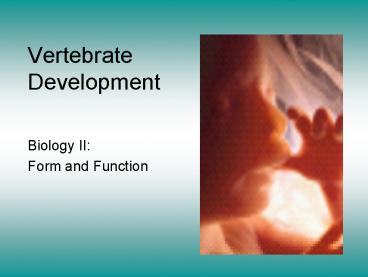Vertebrate Development PowerPoint PPT Presentation
1 / 41
Title: Vertebrate Development
1
Vertebrate Development
- Biology II
- Form and Function
2
The six stages of vertebrate development
- Fertilization
- Cleavage
- Gastrulation
- Neurulation
- Neural crest formation
- Organogenesis
3
Stage of vertebrate development (I)
4
Stage of vertebrate development (II)
5
Fertilization (I)
- Entry of sperm cell induces activation
- prevents other sperm from entering
- Intitiates second meiotic division of egg nucleus
- Induces polarity
6
Fertilization (II)
7
Fertilization in sea urchins
8
Sperm penetration
9
Polarity in early embryos
10
Cleavage
- Division of first cell to many within ball of
same volume (morula) is followed by hollowing of
that ball to a blastula. Form of cleavage and
blastulation depends on orientation of yolk and
nucleus - In primitive chordates, division is even, towards
a symmetrical blastula composed of cells of equal
size - In amphibians, holoblastic cleavage leads to
assymetrical blastula - In reptiles and birds, meroblastic cleavage
occurs, resulting in a cap of cells on top of the
yolk - In mammals, holoblastic cleavage occurs, creating
a trophoblast containing a blastocoel, with inner
disc of cells equivalent to a blastodisc
11
Yolk distribution in amniotic eggs affects
blastula development
12
Holoblastic cleavage
- Cells with little yolk, and central nucleus,
develop evenly
13
Uneven cleavage
- In frog cells, there is more yolk, and nucleus of
fertilized egg is to one side - Yolk slows division, so areas of low yolk content
divide quicker, and create smaller cells (see
here, front) - Areas of high yolk content divide more slowly,
and give rise to larger cells
14
Meroblastic cleavage
- Occurring in reptiles, birds and mammals, an
uneven division of cells causes a cap of cells on
top of the yolk
15
Blastula of mammals and birds
- Cap of cells develops into a blastodisc
- Blastocoel develops in mammals, surrounded by
trophoblast
16
Gastrulation
- Invagination of outer layer of cells to inside of
the blastula is known as gastrulation, resulting
in the formation of the gastrula - Type of gastrulation is a function of type of
blastula - End result is three types of germ layer tissue -
endoderm, mesoderm and ectoderm
17
Gastrulation in the lancelet
18
Gastrulation in the frog
19
Gastrulation in birds
20
Gastrulation in mammals
21
Neurulation and neural crest formation
- Formation of neural fold (primitive streak) above
notocord, begins a channel that eventually seals
on the dorsal surface, forming neural groove - Mesoderm derived tissue close to notocord develop
into somites, giving rise to muscles, connective
tissue and vertebrae - Layer of cells on dorsal surface of groove form
neural crest, responsible for formation of
several important organs - Associated patches of ectoderm tissue derive into
placodes, which evetually result in important
neurally related organs
22
Neural tube formation (I)
23
Neural tube formation (II)
24
Induction
- Proximity of a cell to certain other cells
controls its development - Spemann and Mangold - Cells whose fate can be predicted are termed
determined - Cells whose fate cannot be reversed are termed
committed - Since all cells initially can become any
tissue... ...Development is a process of
progressive restriction of gene expression
25
Spemann and Mangolds dorsal lip transplant
experiment
26
Induction of the vertebrate eye
27
Organogenesis
- Ontogeny recapitulates phylogeny
- (and a quick word about extraembryonic membranes)
28
Derivation of major tissue types
29
Embryonic development of vertebrates (I)
30
Embryonic development of vertebrates (II)
31
Extraembryonic membranes - Chick embryo
32
Extraembryonic membranes - mammalian embryo (I)
33
Extraembryonic membranes - mammalian embryo (II)
34
The placenta
35
Human development
36
Developing human at 4 weeks
37
Developing human at 7 weeks
38
Developing human at 3 months
39
Developing human at 4 months
40
Ultrasound at 5 months
41
Delivery position of foetus

